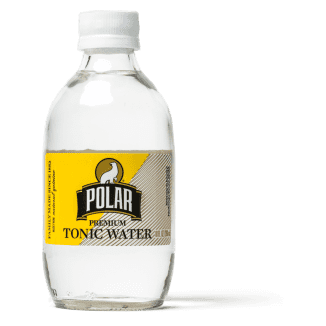As its name implies, tonic water was originally used as a curative. In 19th-century India, where malaria was rampant, quinine, an alkaloid extracted from the bark of the cinchona tree, was the primary means for both preventing and treating the disease. Like all alkaloids, quinine is intensely bitter, so British colonists diluted it with carbonated water, forming a tonic. Later, they improved this tonic’s flavor by adding sweeteners and other flavoring agents. It was only a matter of time before gin, England’s favorite tipple, was incorporated as well.

These days, tonic water is no longer drunk for its medicinal value. In fact, the U.S. Food and Drug Administration now limits the quinine content in tonic water to 83 parts per million; larger doses, while therapeutic for malaria, can actually increase the risk of other health problems. Still, in the time since tonic water was first produced, people around the world have developed a taste for its unique flavor and effervescence. If anything, the popularity of tonic water is on the rise, with more companies than ever developing interesting new formulations of this classic beverage. Curious to know which tonic water was best, we tasted eight nationally available products, priced from about $0.10 to $0.30 per ounce—four supermarket brands and four artisanal brands, all nationally available—plain and in gin and tonics.
A Little Bitterness Is Important
As it turned out, our panel liked most of the tonic waters we tried; finding them all acceptably fizzy. Tasters’ ratings varied, however, depending on the flavor of the tonic.
Not surprisingly, considering the historic use of quinine as a flavoring agent, tasters expected and preferred tonic waters that were moderately bitter. Too much bitterness, as in our two least favorite products, was “off-putting,” making for “strange, sharp, astringent” tonics. Too little bitterness, on the other hand, made for tonic water that was palatable but “not very memorable” and a bit “bland” both plain and in a gin and tonic. Overall, tasters liked tonic waters that were “slightly bitter” but not “overpowering.”

Wondering if the differences in bitterness were due to differences in the amounts of quinine used, we dug a little deeper. Quinine is fluorescent, so we used a black light to illuminate each product to see if there were any differences in how brightly they shone. All the products glowed brightly except one—the product that tasters thought had “no bitterness.” This tonic barely lit up under the black light, indicating that it contained significantly less quinine than the others. The two very bitter products, by contrast, shone just as brightly as the others, suggesting that their bitterness came from the use of other botanicals and not necessarily from a high volume of quinine.

Sweetness Matters
Perhaps to offset all that bitterness, tasters also liked tonic waters that were fairly sweet. Although the tonic waters in our lineup used a variety of sweeteners (high-fructose corn syrup, sugar, and agave), the type of sweetener was ultimately less important than the amount. Tasters preferred tonic waters that had 22 to 26.7 grams of sugar per 10-ounce serving. One product had significantly less sugar—just 13.5 grams per serving; while a few tasters appreciated that it was “not too sweet,” most found it “very dry” and “not sweet enough.” On the other end of the spectrum, the products with the most sugar—27 and 29 grams per serving—were deemed “a touch too sweet” in the mixed drinks. That didn’t stop tasters from liking them, however; as one taster put it, these products were “pretty sweet . . . but hey, that’s tonic!”
Clean, Citrusy Flavors Preferred
Most manufacturers add natural flavors to complement the tonic’s basic bittersweet profile; these usually come in the form of infusions from fruits, herbs, spices, and other botanicals such as lemon grass or juniper. Tasters preferred tonics that were “clean” and “citrus-forward.” Our top-ranking products had “lemony” or “orange”-y flavors that tasters found “bright” and “refreshing.” Our lowest-ranking tonic water, by contrast, was described as “metallic,” “medicinal,” and “slightly fetid”; tasters picked up on unpleasant notes of “mothballs” and “floor cleaner.” These funky flavors may have been a result of the product’s unique processing methods, which involve fermenting botanical extracts—a step not taken by any other company.
Our Winner: Polar Premium Tonic Water
Our favorite tonic water is made by the same company as our favorite seltzer. Both plain and mixed with gin, Polar Premium Tonic Water had a “good balance of sweet to bitter” flavors that were supported by “clean,” “bright,” “citrusy” notes; several tasters declared that it made a “classic G&T.”
- Moderate bitterness
- Moderate sweetness (about 25 grams of sugar per serving)
- Clean, citrusy flavor
- Taste plain
- Taste in gin and tonics










